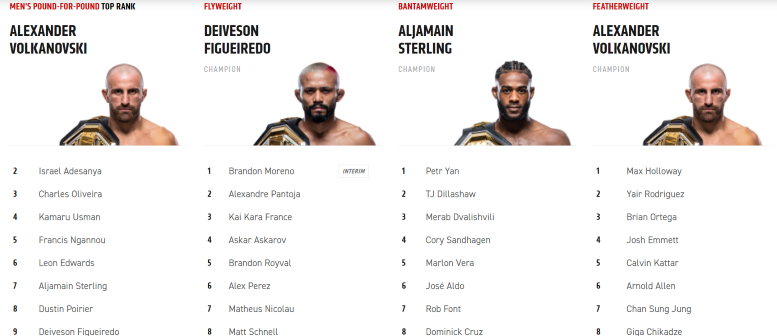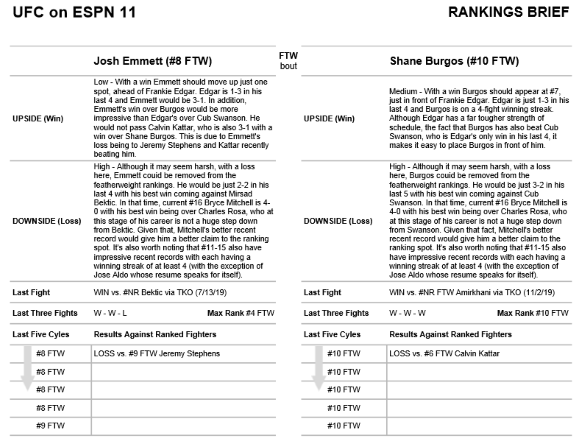
Are you wondering how UFC rankings work?
In this article, we’ll look at how the UFC rankings work, the changes they’ve gone through since they were introduced in 2013, who votes on the UFC rankings, any criticisms of the ranking system, and if there’s anything that can be done to improve how they work.
Contents
How Do UFC Rankings Work?
UFC rankings are voted on by members from 21 MMA media outlets. They’re voting on the top 15 UFC fighters for each weight class, of which there are 11, as well as the men’s and women’s pound-for-pound rankings, making a total of 13.
In the UFC there are 12 weight classes but the women’s featherweight rankings aren’t voted on because there aren’t 15 fighters.
They vote every week, even if there isn’t a UFC event taking place. This is because the rankings can change based on titles being stripped, fighters retiring, and 9-month suspensions rendering a fighter inactive. If there’s an event the rankings change based on its results.
They vote after the finish of the UFC event and give their results to the UFC as soon as possible, as the UFC has 48 hours to average the votes and update the rankings.
If a media outlet misses the 48-hour deadline, their votes from the previous week are submitted. If they miss the deadline twice in a row, they’re removed from the voting panel. All votes are locked and can’t be changed until next week’s vote.
The voting panel is judging without set criteria and is voting with their own thought processes. They are however given a ranking brief by the UFC (example below) before every event, but they don’t have to follow the brief or even read it.
The briefs are there to offer guidance and helpful information like whether a fighter’s eligible to be ranked in a new weight class or ranked again after serving a suspension.
Fighters may be judged based on:
- Current and past results
- Win and loss records
- Title defenses and UFC records
- Methods of victory – knockouts and submissions hold a lot more value than decision victories
- Quality and position of opponents beaten
The most determining factor is results at the most recent UFC event. For example, at UFC 273 in April 2022, #11 ranked Khamzat Chimaev was taking on #2 ranked Gilbert Burns in the welterweight division.
Chimaev won and after the weekend voting, the UFC updated the rankings on Tuesday. Chimaev was ranked #3 and Burns had dropped to #4. This shows the most effective way to climb the rankings is by beating higher ranked opponents as the lower ranked fighter takes the higher ranked fighter’s position.
To give you an idea of voters’ thought processes and information they’re given to determine the new top 15, here’s the ranking brief given to media outlets before UFC on ESPN 11.

Furthermore, there isn’t a vote for champions and interim champions as they’re already decided and sit atop the rankings of their respective divisions. If there’s an undisputed UFC champion, they take the #1 position in their weight class automatically.
If there’s a newly crowned interim champion in a weight class, they take the #1 ranked position as they’re considered the number 1 contender to face the champion above them.
In this case, the media outlets are voting on 14 fighters beneath the two champions of which there are now 16 fighters in the ranking of a particular division.
While champions aren’t included in the weight class rankings, they’re included in the vote for the pound-for-pound rankings.
Note: On the UFC rankings you may see an ‘NR’ box next to a fighter’s name. This stands for ‘Not Previously Ranked’ and applies to new entries that week who’ve entered from outside last week’s top 15.
What Does Pound for Pound Mean in the UFC?
Pound-for-pound, or P4P, is a ranking list of the 15 best UFC fighters from all weight classes. The voting process is exactly the same as explained above and there are two P4P rankings, men’s and women’s.
Many people believe that pound-for-pound means the best UFC fighter regardless of weight division. But the reason there are weight classes is that weight is a huge advantage and a lightweight fighter has no chance against a heavyweight fighter.
Instead, pound-for-pound rankings reflect the fighters who are most dominant in their weight class division, in order from the most dominant to the least.
This is why Kamaru Usman was the number 1 pound-for-pound fighter for so long, as he was very dominant over the welterweight division with a 15-fight win streak and multiple wins over top contenders.
After his loss to Leon Edwards, Kamaru Usman dropped in the pound-for-pound rankings to 4th place. The voters now have Alexander Volkanovski as the pound-for-pound king, with Israel Adesanya in 2nd and Charles Oliveira in 3rd.
Voters believe these 3 fighters are now more dominant in their weight classes than Kamaru Usman is, mainly because he’s no longer the champion.
This shows that the pound-for-pound rankings don’t require a fighter to be a champion, because Charles Oliveira was stripped of the lightweight title after missing weight and is 3rd, and Usman remains 4th.
But it does show that being the champion is usually the best way to show dominance in a division or at least enter the pound-for-pound rankings.
How Do UFC Rankings Work: Have There Been Any Changes?
There have been 6 main changes to how the UFC rankings work since its introduction in February 2013, and these are:
1. Amount of Contenders
Initially, the media outlets ranked only the top 10 contenders, but in December 2013 this was changed to the top 15.
2. Weight Class Divisions
Initially, fighters could only be ranked in one weight class division, but this was changed in 2019 to allow fighters to rank in two divisions or more.
3. Amount of Voters
Upon the first UFC rankings vote in February 2013, there were 28 media members on the panel of voters. There have been as many as 90 voters each week, but currently (2022) there are between 20 to 25 voters each week, 1 from each media outlet.
4. Media Outlet Recruitment
In 2013 the UFC recruited media outlets directly and through an application on its statistics and analysis website, FightMetric, now known as UFC Stats. Since 2017, the UFC and media outlets have been kept separate and the process is conducted by the third-party, Mixed Martial Arts LLC.
The UFC is hands-off with the voting and MMA LLC messages them infrequently to get answers to questions they need to know, mostly concerning whether a UFC fighter is eligible for voting in a particular division, dependent on their contract situation which only the UFC can answer.
However, most of the time these questions are answered in the ranking brief given to each media outlet before an event, which is why the emails are infrequent.
5. Panelist Information
From February 2013 to January 2020, panelists could be seen alongside the UFC rankings. Mixed Martial Arts LLC decided to remove the panelists from the UFC rankings in January 2020 to prevent online criticism and any conflict of interest.
So even the UFC doesn’t know who within the media outlets is voting on the UFC rankings, they only know the media outlets and prefer it this way as it’s another task outsourced that they don’t have to worry about.
6. Pound-for-pound Rankings
From 2013 to 2020, the rankings only included one pound-for-pound ranking for both men and women. This was changed in January 2020, when the UFC created separate pound-for-pound rankings for men and women, taking the total UFC rankings from 13 to 14.
Who Votes on the UFC Rankings?
As previously mentioned, there are currently 21 MMA media outlets that vote on the UFC rankings each week, as decided by Mixed Martial Arts LLC.
Here are the MMA media outlets currently voting on the UFC rankings each week, taken directly from the UFC rankings page.

Any changes to the media outlets are updated here on a weekly basis.
The MMA media outlets are from many different countries around the world, currently including the USA, Sweden, Russia, France, Canada, and Brazil.
For the majority of the media outlets above, the voting is independent of their website and conducted by only one person. Some outlets hold a committee and compile the votes of many members before passing on the average of these to the UFC.
Is There Any Criticism of How the UFC Rankings Work?
Yes, there is plenty of criticism of how the UFC rankings work. Let’s take a look at the criticisms and if there’s anything that can be improved upon.
1. Problem With the Ranking Briefs
While the ranking briefs given are meant as an aid to the voting, some panelists feel their opinion gets lost or outweighed by the general consensus these briefs promote, meaning their votes become outliers.
Others feel the ranking briefs provided should give more extensive information and ideas to help with the voting, but this would push the UFCs agenda on the panel and remove freedom of opinion.
There’s nothing that can be done here and a small amount of information is likely helpful.
2. Lack of Credibility and Transparency
Many of the media outlets have been criticized for not having the credentials and knowledge of MMA to vote and affect the UFC rankings, as some outlets aren’t even MMA-related. Also, previous voters were known to be no longer working in the MMA field.
This lack of credibility and transparency has only been seen as more of an issue since the panelists were removed from the UFC rankings in January 2020, as only Mixed Martial Arts LLC now knows the voters.
However, having a mixed bag of voters is the best, as voters from outside the MMA field don’t have a problem voting because of a conflict of interest or biases.
3. Lack of Diversity
Currently, there’s a lack of diversity in terms of the media outlets, as 75% are from the USA, so incorporating more outlets from outside the USA would be beneficial.
Also, before panelists became anonymous they were 100% male voters, so there could be more of an even split introduced between male and female voters.
4. Lack of Voting Criteria
There’s confusion among voters caused by a lack of criteria on what makes a fighter eligible or ineligible for voting, causing discrepancies and outliers.
To remove uncertainty and mistakes when voting, there should be set rules about inactivity and eligibility, rather than the UFC declaring a fighter is ineligible at random times; because it’s not guaranteed that this information is read by the voter.
If the UFC doesn’t want to involve themselves in the process too much, they could allow the panelists to come together and collectively decide on criteria for what makes a fighter ineligible for ranking.
For example, if a fighter hasn’t fought in a particular weight class for 18 months, they’re no longer considered active status in that weight class and are therefore ineligible for ranking there.
Also, when voting, the panel vote by tweaking their previous week’s vote. This should be changed so that they vote from the current rankings as they are the averages of all the votes.
5. Conflict of Interest and Bias
The fact the panelists are made up of knowledgeable and passionate MMA enthusiasts and insiders have also been criticized. This is because they’re likely to be biased and when combined with a lack of voting criteria and a majority of American panelists, you’re likely to increase this bias in the votes.
Many journalists who’ve worked in the MMA industry for many years have declined to join the voting panel because they see it as a conflict of interest.
Being involved with the UFC and impacting fighters and matchmaking opportunities while also interviewing fighters and having connections with them and their managers is definitely going to induce some bias in the voting. This is the main reason the panelists were made anonymous by MMA LLC.
As mentioned above, it’s best to have a mixed panel of those working in the MMA field and those outside of it, which can remove biases and level the playing field.
Overall
The UFC ranking system isn’t even a decade old and can likely be improved in many ways. However, no matter the improvements made, there will always be criticism.
It’s been suggested the UFC should handle the voting themselves and make it as scientific as possible, as they have the resources to do so. Again though, it’s a conflict of interest and would be heavily criticized.
The Bottom Line
So, ‘how do UFC rankings work’?
They work by having 20 or so voters, one from each MMA media outlet, vote each week on the top 15 fighters for a total of 13 rankings: 11 weight classes, and 2 pound-for-pound rankings.
It would be 14 rankings as there are 12 UFC weight classes, but the women’s featherweight division isn’t voted on because there aren’t 15 fighters.
At the end of the day, the UFC rankings receive a lot of criticism but they’re used only as a matchmaking guideline by the UFC hierarchy.
If a fighter falls outside the top 15, they only have to beat someone inside it to reenter the rankings the next time they fight, so it’s unlikely to affect their career in terms of matchups, earning potential, contract negotiations, etc.
Overall, in MMA and the UFC, there will never be a perfect ranking system because fighters aren’t fighting the same number of times per year.




